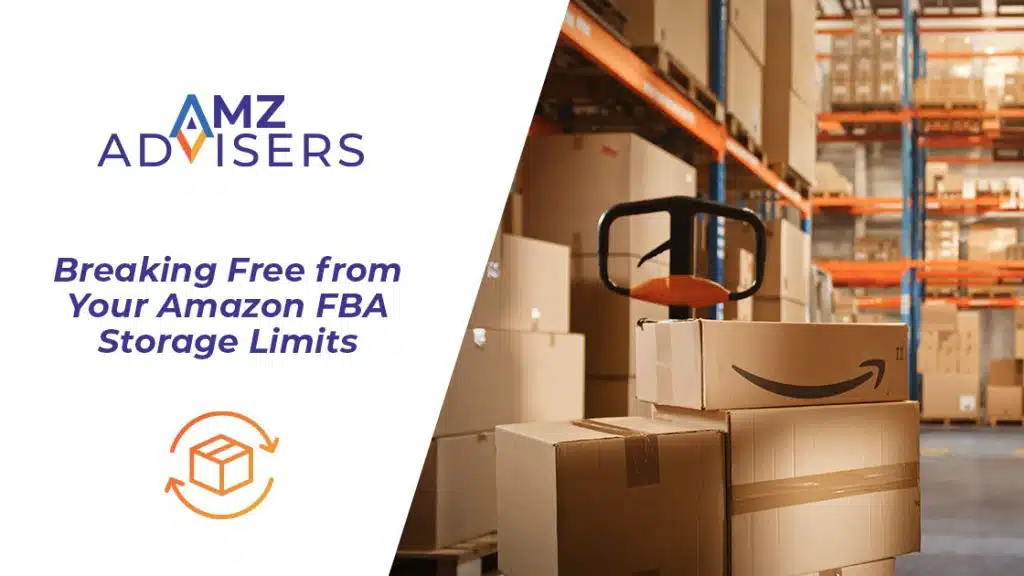The Amazon Partnered Carrier program can speed up deliveries, and even boost sales. Time to cut down your shipping headaches!
We all know by now that Amazon has definitely figured out the art of getting products from point A to point B. However, not everyone knows that Amazon partnered carriers make that process easier for sellers.
This service lowers shipping rates for FBA brands. It also delivers your products to any Amazon warehouse in the US.
Here’s everything you need to know about the Amazon carrier program for Fulfilled by Amazon (FBA) sellers or aspiring carriers.
Who are Amazon Partner Carriers?
The Amazon Partnered Carrier program is a shipping service that Amazon offers to help sellers move their goods to fulfillment centers.
Selected partner carriers have a direct relationship with Amazon, which gives them some unique benefits. For example, discount shipping rates and easy integration with Seller Central.
This means sellers can manage shipping arrangements, print Amazon shipping labels and track shipments without using a lot of different platforms. From here on, all packages arrive ready for online sale.
The rate is invoiced to your account as an inbound transportation charge. Brands will only pay for the trailer area they use to send parcels to an Amazon fulfillment center.
Imagine you sell organic candles through Amazon. Without a partnered carrier, you’d need to find your own shipping company, negotiate rates, and hope everything arrives on time. This process can be time-consuming and stressful, especially if something goes wrong.
However, with a partnered carrier, Amazon takes care of much of the heavy lifting. All you need to do is log into Seller Central, input your shipment details, and choose one of the pre-approved carriers. The carrier picks up your inventory, and you’re good to go.
Why Use Amazon Partnered Carrier?
The program also features many special benefits for enrolled sellers. For example:
- Easy to start up.The program does not require a special sign-up nor a minimum shipment parcel.
- Loss coverage. Amazon will take full responsibility for damage or lost products during delivery.
- Fast processing. Partnered carrier shipments benefit from processing priority. So, products sent using the program have a faster delivery rate.
- Secure packaging. Large shipments are packed with foil and bubble wrap for additional protection.
- Tracking Data. Brands can track shipments from the Seller Central dashboard. Here, you can review pickup dates, reference and landing numbers, PRO and PO numbers.
Brands can ship almost every article they can think of via the Amazon Partnered Carrier program―unless it’s otherwise stated in the dangerous goods identification guide.

What Carriers Are Used by Amazon?
Amazon works with a lot of different carriers, and they all offer specialized services depending on your shipping needs. Some of the main to keep in mind are:
UPS
UPS is a go-to carrier for domestic shipments. They have a vast network and a reputation for reliability. For sellers, this means you can trust UPS to handle your shipments with care, making sure they arrive at Amazon’s fulfillment centers on time.
Let’s say you’re shipping fitness equipment from California to an Amazon warehouse in Texas. With UPS, you get efficient transit times and shipment tracking updates every step of the way.
USPS
USPS often handles smaller, lightweight packages, especially for deliveries to rural or remote areas―even on weekends, sometimes. Their extensive reach makes them ideal for areas where private carriers might charge a lot of extra fees.
DHL
DHL focuses on international shipping. Sellers who export products to warehouses in Europe, Asia, or other regions often choose DHL for their gl expertise and smooth customs processes.
A seller in the US might use DHL to ship skincare products to an Amazon Germany warehouse, knowing that DHL’s experience with international regulations will help avoid delays.
Amazon Logistics
Amazon also operates its own logistics service for last-mile deliveries, which works together with the Amazon DSP program. This means they handle the final leg of the journey, delivering packages from local distribution centers directly to customers’ doorsteps.
Regional Carriers
In certain countries, Amazon partners with local carriers like Canada Post in Canada or India Post in India. These partnerships ensure efficient shipping in areas where global carriers might not be as accessible.
Related content: Remote Fulfillment on Amazon
Amazon Partnered Carrier Options
Amazon Partnered Carrier features 3 shipment options for sellers:
Small Parcel Deliveries (SPD)
SPD shipments comprise small unit bulks packed in separate boxes. Each box counts as an individually labeled package sent to Amazon via UPS (Canada and the US) or DHL (Mexico).
SPD shipments have a 200-box limit, which are deliverable to the 48 contiguous US states. As we said above, Amazon will provide you with the labels to use with their approved carrier.
Amazon also calculates the cost using the packing information, shipment address and destination. But the most important metric is the billable weight, which is rated in 1 of 2 options:
- Shipment weight.The real weight of the shipment, based on weight per parcel.
- Dimensional weight.Packaged density, based on the package dimensions.
Note that there is a 1lb-minimum charge for SPD shipments. So, if your parcel weighs less than 1lb, you’ll be charged a shipping fee.
LTL & FTL
Full-Truckload (FTL) and Less-Than-Truckload (LTL) are the options for shipments that weigh over 150lbs. Both models are also the best choice for brands shipping less than 100 items.
These services do not transport individual packages. Sellers must combine boxes on pallets. This is crucial for shipment, because your stock will share space in a trailer or freighter. Of course, you’ll only pay for your own space on the transport.
Carrier fees are also calculated using packing data, shipment address, destination and billable weight. Plus, LTL and FTL carriers must meet specific requisites:
- Support truck arrival to the warehouse for shipment.
- Forklift or dock door to store the pallets on a truck.
- 40 x 48 inches wooden pallets with 4-way access.
- Pallets must be GMA Standard B Grade or higher.
Sellers who don’t have a dock door or forklift can request a lift-gate service. This is supported by all partnered LTL carriers.
When using lift-gate service, you can only ship up to 12 pallets, each measuring 1.0 x 1.2 meters, with 4-way access. Plus, the shipment should not exceed 20,000 lb.
Before shipment, make sure you provide the following data to the carriers:
- Freight-ready date
- Pallet count and weight
- Freight class
The freight class system rates the risk and billable weight of a shipment. Carriers use package data to estimate your freight class. So, make sure you provide accurate information.
Accepted freight classes rank from 50 to 500. Rejected classes may incur reviews and delayed pickups.
Related content: Fulfilment Provider Optimization

How to Enroll in the Amazon Partnered Carrier Program
If you’re in the logistics business, working as an Amazon carrier could be a big opportunity. It means steady work, a chance to grow your business, and the benefit of partnering with one of the most trusted names in the world. But getting started takes some preparation.
Amazon Requirements
Make sure your business meets Amazon’s standards. They’re looking for reliable partner carriers who can handle deliveries without issues. Some of the main requirements include:
- Strong track record. Amazon wants to work with companies that have a history of on-time deliveries and reliable service. If you already have a good reputation in the logistics world, you’re off to a great start.
- Good insurance coverage. You’ll need to carry insurance, including general liability, cargo, and potentially workers’ compensation.
- Capacity to scale. You’ll need enough vehicles and drivers to manage Amazon’s volume, especially during busy times like the holidays.
Apply to the Program
The application process starts at Carrier Central, Amazon’s online portal for logistics partners. You’ll fill out a form with information a lot information like:
- Business Details. Amazon will need proof of your business registration, like your tax ID and legal documentation.
- Territories. Be clear about the areas you can serve—local, regional, or even nationwide.
- Fleet details. Amazon will ask about your vehicles, their size, and what kind of loads they can carry.
- Technology. If you have tracking systems or software in place, make sure to mention them. Amazon values tech-savvy businesses that can integrate with their systems.
Double-check your application before submitting it. Incomplete details or missing documents could slow things down or lead to rejection.
Go Through the Screening Process
Once you apply, Amazon will look at whether your fleet and drivers can handle the volume of deliveries they require. They’ll also make sure your business meets all licensing, insurance, and safety requirements.
Lastly, if you’ve been in logistics for a while, Amazon may look at your delivery record and customer feedback.
Training and Onboarding
Amazon will train you to meet their standards and use their systems. You’ll learn about key performance goals like on-time deliveries and low error rates. Amazon will also teach you how to use its tools, such as Amazon Relay, to manage shipments and track deliveries in real-time.
Amazon Partnered Carrier Tracking Information
Being part of the Amazon Partnered Carrier program can cut down your shipping headaches in a flash. You get access to the Amazon carrier logistics machine to speed up shipments.
With no special sign-ups, the Partnered Carrier program is open to all Amazon FBA sellers. Thus, you can reduce delivery times, protect your inventory, and boost sales.
The program can surely meet the fulfillment needs for Amazon stores in a safe way. Plus, you can also speed up customer deliveries, increasing delight and sales.
Related content: The Magic Behind Amazon Automation
How to Cancel a Shipment
There’s a 24-hour window to cancel SPD shipments. The cancellation timeframe for LTL/FTL carriers is up to 1 hour. However, you can only do so after you approve the estimated fees.
- Go to the shipping queue and locate your shipment.
- Click on Work on shipment and select Provide details.
- Click on Void charges.
Note that cancelling a shipment does not forfeit any fees. You must follow the steps above to make sure the charges won’t apply, and no pickup is made.
The Main Benefits for Carriers and Sellers
Whether you’re running a business on Amazon or delivering packages for a living, th Amazon Partnered Carrier program offers many helpful benefits.
For Sellers
- Lower shipping costs. Shipping can get expensive, especially with heavy or large shipments. Amazon works out deals with carriers to give you lower rates. Say you need to ship 1,000 units of a product that weighs 20 pounds. With a partnered carrier, you might pay $10 per box instead of $25. That saves you $15,000—money you can spend elsewhere in your business.
- Easy to use. The program simplifies shipping by letting you handle everything through Seller Central. When you set up a shipment, just choose a partnered carrier. Amazon generates your labels, and the tracking info updates automatically.
- Faster deliveries. Using a partnered carrier can help get your products into Amazon’s warehouses faster. These shipments are often processed more quickly, especially during busy times like the holidays.
- Reliable shipping. Amazon’s partnered carriers are carefully chosen for their reliability. This means fewer lost or delayed packages, which helps keep your customers happy and your seller ratings high.
For Carriers
- Steady work. Amazon ships millions of packages every day. As a partnered carrier, you’ll get consistent work, which will help you keep your business running without having to chase clients on your own.
- Reputation boost. Working with Amazon can boost your credibility. Other businesses and customers will trust you more because you’re partnered with one of the world’s biggest companies.
- Growth opportunities. Amazon is expanding into new markets worldwide, and partnering with them gives you the chance to grow alongside them. So it doesn’t matter if you focus on local or international shipping, there’s room to scale up.
- Better technology. Amazon gives partnered carriers access to advanced tools like real-time tracking. These tools help you improve efficiency and deliver better service.
Final Thoughts
The Amazon Partnered Carrier Program can cut down your shipping headaches in a flash. You get access to the Amazon carrier logistics machine to speed up shipments.
With no special sign-ups, the program is open to all FBA sellers. Thus, you can reduce delivery times, protect your stock and boost sales. Plus, you can also speed up customer deliveries, increasing delight and sales.
For sellers, it’s a simple way to cut costs and get your products to Amazon fulfillment centers smoothly. For carriers, it’s a great chance to grow your business by teaming up with a giant in eCommerce.
Authors
 Esteban Muñoz is a content manager with several years’ experience in digital marketing and ecommerce. He’s been able to achieve incredible growth for his associates by optimizing and managing their accounts, and creating in-depth content marketing strategies.
Esteban Muñoz is a content manager with several years’ experience in digital marketing and ecommerce. He’s been able to achieve incredible growth for his associates by optimizing and managing their accounts, and creating in-depth content marketing strategies.
 Antonella Fleitas is highly adept at creating fact-based, evergreen content about science, language learning, and culture. Her main goal is to build a strong content foundation for her clients, based on meaningful stories that people can learn from.
Antonella Fleitas is highly adept at creating fact-based, evergreen content about science, language learning, and culture. Her main goal is to build a strong content foundation for her clients, based on meaningful stories that people can learn from.




